剑桥雅思9:Test4雅思阅读PASSAGE1真题+答案+解析
发布时间:2021-06-28 关键词:剑桥雅思9:Test4雅思阅读READING
READING PASSAGE 1
You should spend about 20 minutes on Questions 1-13, which are based on ReadingPassage 1 below.
The life and work of Marie Curie
Marie Curie is probably the most famous woman
scientist who has ever lived. Bom Maria Sklodowska
in Poland in 1867, she is famous for her work on
radioactivity, and was twice a winner of the Nobel
Prize. With her husband, Pierre Curie, and Henri
Becquerel, she was awarded the 1903 Nobel Prize for
Physics, and was then sole winner of the 1911 Nobel
Prize for Chemistry. She was the first woman to win a
Nobel Prize.
From childhood, Marie was remarkable for her
prodigious memory, and at the age of 16 won a gold
medal on completion of her secondary education. Because her father lost his savings throughbad investment, she then had to take work as a teacher. From her earnings she was able tofinance her sister Bronia's medical studies in Paris, on the understanding that Bronia would, inturn, later help her to get an education.
In 1891 this promise was fulflld and Marie went to Paris and began to study at the
Sorbonne (the University of Paris). She often worked far into the night and lived on litl morethan bread and butter and tea. She came first in the examination in the physical sciences in1893, and in 1894 was placed second in the examination in mathematical sciences. It was notuntil the spring of that year that she was introduced to Pierre Curie.
Their marriage in 1895 marked the start of a partnership that was s00n to achieve results ofworld significance. Following Henri Becquerel's discovery in 1896 of a new phenomenon, whichMarie later called 'radioactivity', Marie Curie decided to find out if the radioactivity discoveredin uranium was to be found in other elements. She discovered that this was true for thorium.Turning her attention to minerals, she found her interest drawn to pitchblende, a mineralwhose radioactivity, superior to that of pure uranium, could be explained only by the presencein the ore of small quantities of an unknown substance of very high activity. Pierre Curie joinedher in the work that she had undertaken to resolve this problem, and that led to the discoveryof the new elements, polonium and radium. While Pierre Curie devoted himself chiefly to
the physical study of the new radiations, Marie Curie struggled to obtain pure radium in themetallic state. This was achieved with the help of the chemist André-Louis Debierne, one of Pierre Curie's pupis. Based on the results of this research, Marie Curie received her Doctorateof Science, and in 1903 Marie and Pierre shared with Becquerel the Nobel Prize for Physics forthe discovery of radioactivity.
The births of Marie's two daughters, Irene and Eve, in 1897 and 1904 failed to interupther scientific work. She was appointed lecturer in physics at the Ecole Normale Superieure forgirls in Sevres, France (1900), and introduced a method of teaching based on experimental
demonstrations. In December 1904 she was appointed chief assistant in the laboratory directedby Pierre Curie.
The sudden death of her husband in 1906 was a bitter blow to Marie Curie, but was also aturning point in her areer: henceforth she was to devote all her energy to completing alonethe scientific work that they had undertaken. On May 13, 1906, she was appointed to theprofessorship that had been left vacant on her husband's death, becoming the first woman toteach at the Sorbonne. In 1911 she was awarded the Nobel Prize for Chemistry for the isolationof a pure form of radium.
During World War I, Marie Curie, with the help of her daughter lrene, devoted herself to thedevetopment of the use of X-radiography, including the mobile units which came to be knownas Little Curies, used for the treatment of wounded soldiers. In 1918 the Radium Institute,whose staff Irene had joined, began to operate in eamest, and became a centre for nuclearphysics and chemistry. Marie Curie, now at the highest point of her fame and, from 1922, amember of the Academy of Medicine, researched the chemistry of radioactive substances andtheir medical applications.
In 1921, accompanied by her two daughters, Marie Curie made a triumphant jourmey to theUnited States to raise funds for research on radium. Women there presented her with a gram ofradium for her campaign. Marie also gave lectures in Belgium, Brazil, Spain and Czechoslovakiaand, in addition, had the satisfaction of seeing the development of the Curie Foundation in
Paris, and the inauguration in 1932 in Warsaw of the Radium Institute, where her sister Broniabecame director.
One of Marie Curie's outstanding achievements was to have understood the need toaccumulate intense radioactive sources, not only to treat ilness but also to maintain anabundant supply for research. The existence in Paris at the Radium Institute of a stock of 1.5grams of radium made a decisive contribution to the sucess of the experiments undertakenin the years around 1930. This work prepared the way for the discovery of the neutron bySir James Chadwick and, above all, for the discovery in 1934 by Irene and Frederic Joliot-Curie of atificial radioactivity. A few months after this discovery, Marie Curie died as a resultof leukaemia caused by exposure to radiation. She had often carried test tubes containingradioactive isotopes in her pocket, remarking on the pretty blue-green light they gave off.Her contribution to physics had been immense, not only in her own work, the importanceof which had been demonstrated by her two Nobel Prizes, but because of her influence onsubsequent generations of nuclear physicists and chemists.
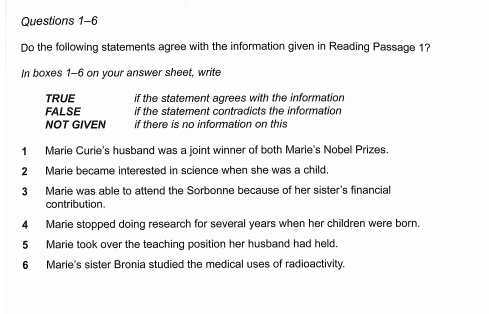
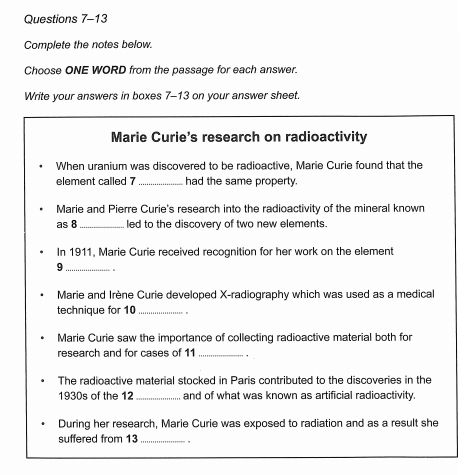
剑桥雅思9Test4阅读Passage1答案:
Question 1—6:F、NG、T、F、T、NG
Question 7—13:thorium、pitchblende、radium、soldiers、illness、neutron、leukaemia/leukemia
Passage1整体分析
体 裁 记叙文
题 材 人物介绍
主 题 玛丽·居里的生活与工作
段落概括 段 简要介绍玛丽·居里的成就
第二段 介绍玛丽读书和工作的经历
第三段 讲述玛丽读大学时在物理学科崭露头角
第四段 介绍玛丽在研究中的初步成果
第五段 绍玛丽和皮埃尔合作后的科研成就
第六段 介绍玛丽在大学和实验室的主作职责
第七段 讲述玛丽在丈夫去世后自己独自取得的科研成就
第八段 讲述玛丽将她的科研成果运用到医学中去
第九段 介绍玛丽推动居里基金会的发展和镭研究所的成立
第十段 讲述玛丽在镭方面所取得的成果为后人研究做的铺垫以及她的去世
第十一段总结玛丽对物理学的贡献
雅思阅读重点词汇
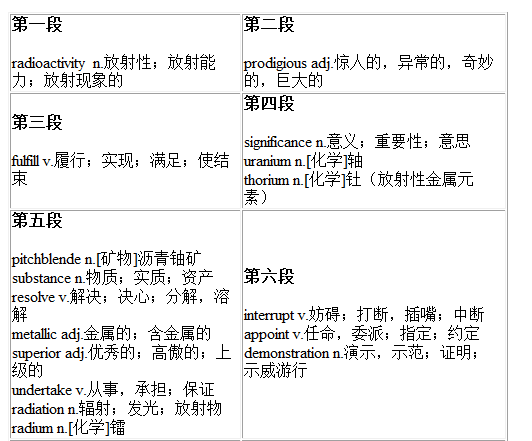
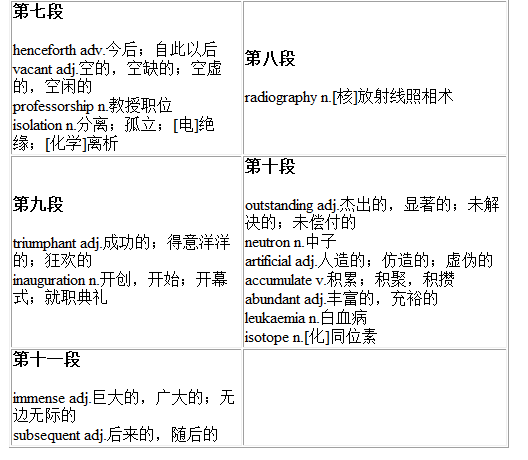
考题精解
Questions 1-6
题型:判断题 TRUE/FALSE/NOT GIVEN
解析:判断题一般都是按照正序出题,确定了个题目在原文中的定位,便可根据顺序原则依次寻找其他题自的答案。做判断题时注意找出定位词,定位可以帮助考生迅速在原文中找到出题位置,考点词用于确定题干的判断点。
1.
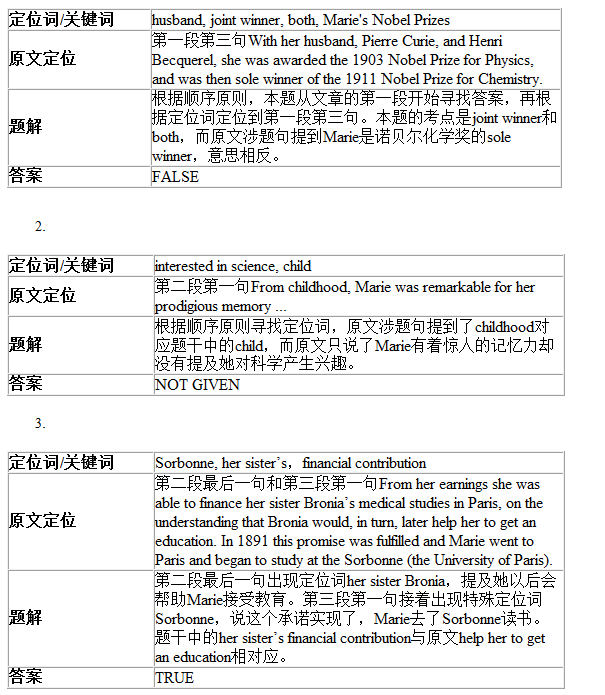
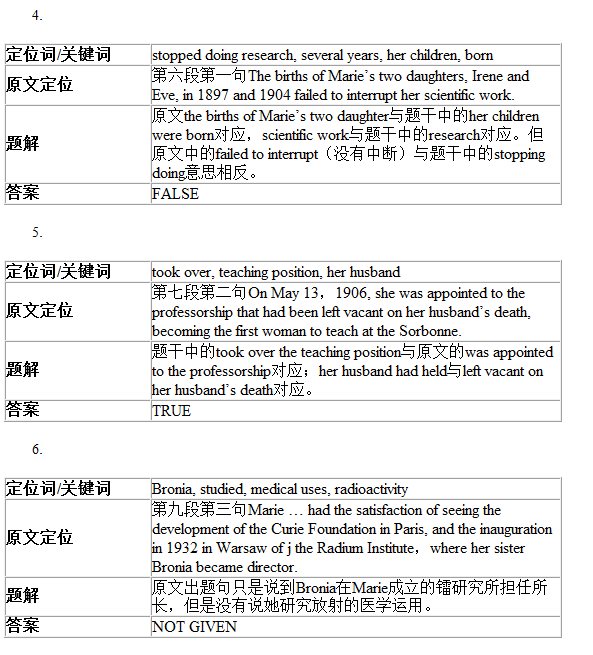
Questions 7-13
题型:笔记填空题NOTE COMPLETION
解析:本题型力笔记填空题,答案一般是原文中出现的单词。做题时考生要遵循顺序原则,弄清楚空格词与周围词的搭配关系,并同时判断空格词的词性。填空题要注意答案的字数要求。
7.
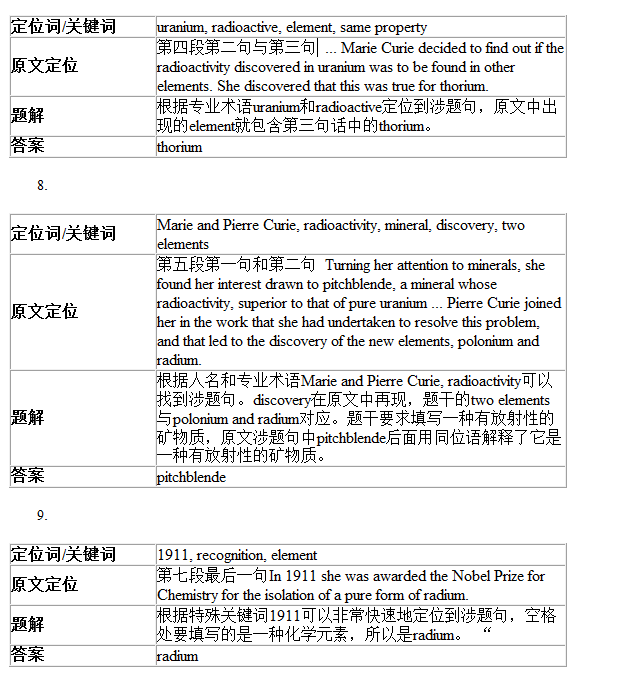
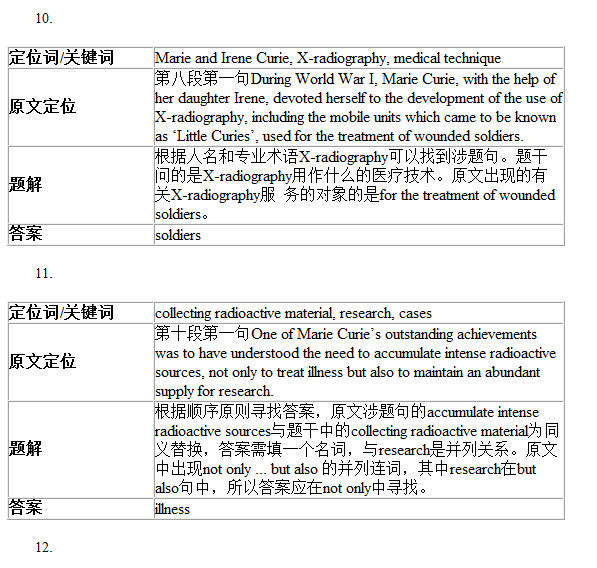
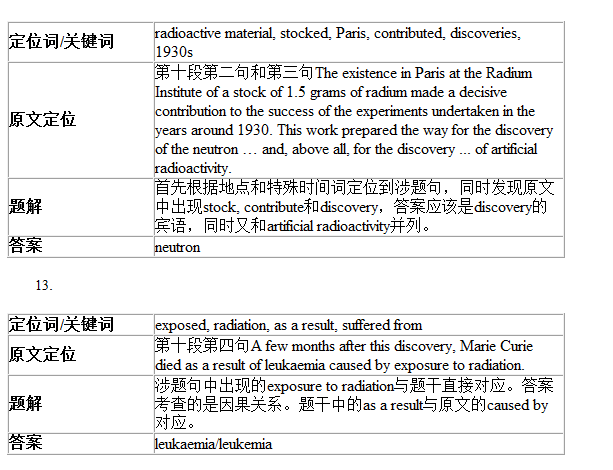
剑9阅读难句解析
1. Turning her attention to minerals, she found her interest drawn to pitchblende, a mineral whose radioactivity, superior to that of pure uranium, could be explained only by the presence in the ore of small quantities of an unknown substance of very high activity..
解析:在这个复合句中,主句是she found her interest drawn to pitchblende,后面的a mineral和pitchblende是同位语关系,mineral后面又出现定语从句whose radioactivity ... could be explained ...,中间的superior to that of pure uranium 是定语从句的插入成分。
参考翻译:随着把注意力转向了矿物质,她发现自己对沥青铀矿产生了兴趣,这种矿物质的放射性优于纯铀矿石的放射性,其放射性只能够通过它存在于少量的一种未知的非常高活性的矿石中得到解释。
2. Marie also gave lectures in Belgium, Brazil, Spain and Czechoslovakia and, in addition, had the satisfaction of seeing the development of the Curie Foundation in Paris, and the inauguration in 1932 in Warsaw of the Radium Institute, where her sister Bronia became director.
解析:首先in addition连接了两个并列句。在后半句中,seeing后跟了两个并列宾语the development和the inauguration。The Radium Institute作为先行词,由关系副词where引导的一个定语从句作补充说明。
参考翻译:此外,玛丽也在比利时、巴西、西班牙和捷克斯洛伐克举办了讲座,此外,她还满意地看到在巴黎的居里基金会的发展和1932年镭研究所在华沙的创立, 研究所由她妹妹波妮娅担任所长一职。




